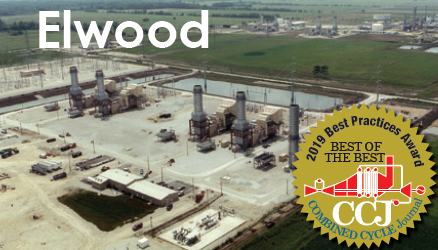Developing the next generation of multi-skill employees
Elwood Energy started commercial operation in 1999. In 2012, prior to the plant’s first ownership change and exit from a PPA environment, the leadership team realized it would have to develop its next generation of employees. Few job candidates with suitable experience demonstrated sufficient promise to thrive in a multi-skill position.
Retirement and attrition left Elwood with only four of its 13 OMTs (operating/maintenance technicians). Opting for potential over experience, based on early success with a developmental program, the nine candidates hired had either a two- or four-year degree, but minimal relevant experience. Now five years into this program, the average age of the group is 27, with relevant experience averaging four years.
Elwood Energy operates in the PJM capacity performance market where performance is rewarded and failure to perform can be very costly. One hour of unplanned outage for one unit can vary from $35,000 in lost capacity payments to $600,000 in penalties during a capacity performance event. For a PJM peaking facility typically operating a unit 400 hours annually, every hour troubleshooting a failure to start can be very costly.
An employee who can work through an issue in two hours can be much more valuable than a less capable employee requiring six hours. Developing a dedicated competent multi-skill staff of OMTs is essential to maintain equipment reliability as well as to promptly resolve equipment malfunction.
Critical to success were the following actions, among others:
- 1. When candidates with demonstrated progressive and relevant work experience are not available, seek out and recruit those with a demonstrated potential to learn. Recruit candidates with two- to four-year degrees who have a demonstrated good work ethic and high aptitude for electrical, I/C, and mechanical maintenance. Offer part time work to promising candidates still in college.
- 2. Put emphasis on retaining experienced employees. Leverage their experience across your developing employees at every opportunity. Success in developing your future generation of employees requires experienced working supervisors who enjoy developing others.
- 3. Ensure your highly experienced employees can delegate and control increasingly complex skills as employees’ capabilities increase. The highly experienced employees may need growth assignments as well.
- 4. Develop a qualification program that captures the operational and maintenance skills and knowledge expected of OMTs.
- 5. Provide well-considered annual performance appraisals.
- 6. Foster a competitive environment where the more capable and driven employees can develop a strong culture.
- 7. Know what developing job skills are worth to competitors and be sure to match compensation increases with increasing skills. Slow recognition of increased value may end up in a lost developmental candidate.
- 8. Have an incentive plan that is aligned with the goals of the owners regarding EFORd, starting reliability, unit trips, compliance with regulations, and plant net income.
Learn more from our Best Practices Awards sponsor
Hiring for capability and leveraging of Elwood’s existing capabilities has been essential to the plant’s success. Elwood has experienced numerous transitions in four ownership changes—switching from PPAs to PJM and then to the PJM capacity performance environment requiring rotating shift coverage.
During this period of change, staff has maintained a safe work environment and strong operational performance—with low EFORd, high starting reliability, and low unit trip performance demonstrated yearly. The O&M team missed very few market opportunities that lost energy margin or capacity payments.
While recent college graduates can approach work with great enthusiasm and capability, they don’t know what they don’t know. They also are less likely to bring with them undesirable expectations and behaviors than many experienced candidates. One of the changes we managed was moving from working directly for the ownership to one of working for service provider NAES Corp.
NAES has provided support in a few key areas that some of the ownership structures did not. Safe work performance, a key measure of operational excellence, is communicated by NAES and embraced by the Elwood staff. Programs, guidance, and support to develop safety, environmental, and NERC programs greatly enhanced the development of Elwood personnel.
The leadership team has effectively managed the change from a summer peaking facility working under a PPA with the facility unmanned at night and weekends, to a significantly riskier environment where capacity payments can be lost any hour of the year.
The foregoing strategy has been a key factor in achieving challenging business goals year after year despite the significant changes experienced. The new team forged has achieved years of consistent employee performance development conducive to supporting Elwood Energy’s business objectives well into the future.
Elwood Energy, owned by J-Power USA and operated by NAES Corp, is a 1350-MW, nine-unit peaking facility in Elwood, Ill. Plant manager is Joseph Wood.










